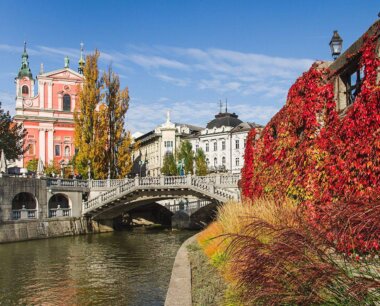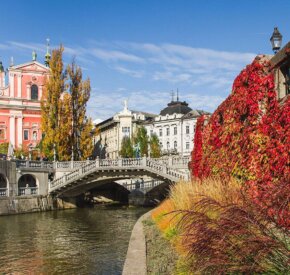
World Penguin Day: Where to see penguins in the wild
We’ve rounded up the world’s top spots to focus on for your best chance of a close encounter, and the species of penguins you’ll find there…
What is it about penguins that make them so gosh darn cute? Is it the waddling? The fact that they kind of look like they’re wearing a suit? A lingering love for Pingu into adulthood, even if real penguins don’t actually say noot noot?
Whatever it is, we’re big fans – so there’s no chance we’d miss the chance to mark World Penguin Day.
Want to see penguins in the wild for yourself? We’ve rounded up seven of the top destinations for doing just that, as well as the species you’ll find there…
1. Antarctica: Emperor penguin

The largest of all penguins at almost 1.3m tall, the emperor penguin lives in the coldest climate on earth – where temperatures can plummet as low as -60ºC. During the freezing Antarctic winter, female emperors transfer their egg to the feet of the males to incubate while they feed in the sea. Over the harsh winter the males do not eat, and huddle in groups to stay warm.
According to the WWF, Emperor penguins are the least common Antarctic penguin, with between 260,000 and 280,000 breeding pairs, and they hold Near Threatened status. If you want to see them for yourself, book in for an expedition to Snow Hill Island as there is a large colony based there.
2. Falkland Islands: Rockhopper penguin

The rockhopper penguin is easy to identify, with its slicked-back eyebrows and odd habit of hopping rather than waddling. They are often spotted along the craggy windswept shores of sub-Antarctic islands, from Chile to New Zealand. These sociable marine birds are among the world’s smallest penguins at only 50cm high. They have blood-red eyes, orange beaks and pink webbed feet.
The Falkland Islands have some of the world’s largest rockhopper colonies: they can be found on the north coast at Cape Bougainville. The Cape is reached from Salvador by off-road tracks, so hire a driver or guide who understands the terrain and techniques required to cross it. Alternatively, some Antarctica cruises take in the Falklands and South Georgia (see king penguins below) enroute and will endeavour to show passengers rock hoppers on their shore excursions.
3. Ecuador: Galápagos penguin

The Galápagos penguin is the only penguin species found north of the equator. These small penguins (which average 49cm in height) were brought to the Galápagos by the Humboldt Current, which runs from Antarctica up the west coast of South America, bringing cold water and nutrients with it. The Galápagos penguin mates for life, and the mating season is year-round. They breed mainly in caves or crevices of old lava flows and in burrows.
With a population smaller than 2,000, the Galápagos penguin has been declared an endangered species. They can be found on Fernandina, Isabela, Santiago, Bartolome, northern Santa Cruz and Floreana. It is rare to see penguins on the other islands of the Galápagos.
4. Ross Island: Adélie penguin

No other bird on earth breeds further south than the tobogganing Adélie penguin. This medium-sized penguin can be recognised by a white ring around its eye and the end of its bill. They mostly live on small islands off the Antarctic coast. Many people believe the Adélie penguin to be a fun-loving bird as they are often seen tobogganing around the ice on their bellies. It may look like a game, but these small birds actually use the movements to stop themselves from getting worn out when moving around on the ice.
There are around five million Adélie penguins in the Ross Sea area, all living in very large colonies. The best place to see them is on Ross Island, in southern New Zealand.
5. Australia: Little penguin

This penguin lives up to its name: it is the smallest of all penguins at only 30cm tall, and weighs only 3.3lbs. The little penguin can be found on the southern shores of Australia and New Zealand, with rare sightings in Chile. It has other common names in its various homes: fairy penguin in Australia due to its tiny size, and blue penguin in New Zealand because of its blue feathers.
6. South Georgia: King penguin

King penguins are the second largest of all penguins, and are often mistaken for emperor penguins. However, unlike emperors, king pairs share the incubation of the egg rather than leaving the male alone to do it. King penguins breed and live in northern Antarctica on South Georgia and other temperate islands in the area.
The best place to spend a day with these beauties is on South Georgia Island, which has around half a million king penguins, but access is only by boat such as on an expedition cruise, usually combined with a visit to Antarctica. You’ll be wowed, not only by the rugged beauty of South Georgia, but by the unforgettable sight of huge colonies of over 100,000 penguins at St Andrews Bay and Salisbury Plain.
7. New Zealand: Fiordland penguin

These penguins grow no taller than 55cm in height, and are rather timid and solitary. They live and breed on the south west coast of New Zealand’s South Island, and can be identified by their blueish head and wide yellow eyebrows. The habits of fiordland penguins have been difficult for scientists to monitor, due to their hidden nesting areas in thick vegetation.
The best viewing sites for fiordlands are Stewart Island and Munroe Beach, in New Zealand. Plan your trip between July and November for the best chance of a sighting, as these shy birds stay in their breeding colonies during the season. Wilderness Lodge Lake Moeraki, in South Westland, offer daily guided and tailored wildlife tours.




















